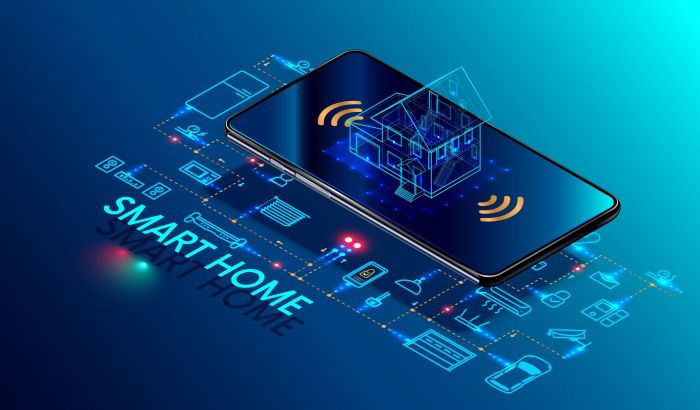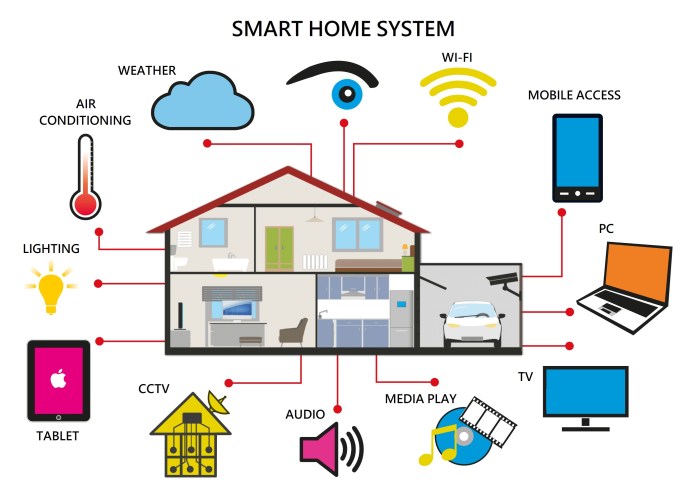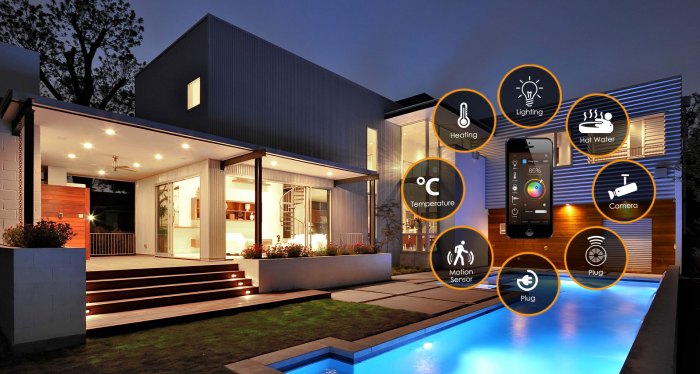Smart home system with integration with smart devices – Welcome to the realm of Smart Home Systems: Seamless Integration with Smart Devices. This comprehensive guide will delve into the captivating world of smart homes, where convenience, security, and energy efficiency intertwine effortlessly. Get ready to discover how smart home systems revolutionize modern living.
As the demand for smart homes skyrockets, this article aims to provide a clear understanding of the integration between smart home systems and various smart devices. We’ll explore the types, benefits, and essential components of smart home systems, ensuring you have all the knowledge you need to embrace the future of home automation.
Introduction to Smart Home Systems

Smart home systems integrate connected devices, appliances, and services to automate tasks, enhance convenience, and improve home security and energy efficiency. These systems typically include a central hub or app that connects to and controls various smart devices within the home, enabling remote access and centralized management.
Smart homes are gaining popularity due to their numerous benefits, including:
- Increased convenience and automation: Smart home systems automate routine tasks such as turning lights on/off, adjusting thermostats, and locking doors, freeing up time for other activities.
- Enhanced security: Smart security systems can monitor for intruders, smoke, and leaks, and send alerts to homeowners or emergency services.
- Improved energy efficiency: Smart thermostats and lighting systems can optimize energy consumption based on usage patterns, reducing utility bills.
- Personalized experiences: Smart home systems can tailor experiences to individual preferences, such as setting up customized lighting scenes or creating personalized music playlists.
Integration with Smart Devices

Smart home systems seamlessly connect with a wide range of smart devices, empowering you with unparalleled control and automation over your living space.
Integration with smart devices enables you to monitor, manage, and interact with various aspects of your home, from lighting and temperature to security and entertainment.
Smart Device Compatibility
Smart home systems are designed to work with a diverse array of smart devices, including:
- Smart lighting (e.g., Philips Hue, LIFX)
- Smart thermostats (e.g., Nest, Ecobee)
- Smart speakers (e.g., Amazon Echo, Google Nest Hub)
- Smart plugs (e.g., Belkin WeMo, TP-Link Kasa)
- Smart doorbells (e.g., Ring Video Doorbell, Arlo Video Doorbell)
- Smart security cameras (e.g., Wyze Cam, Blink XT2)
Types of Smart Home Systems

Smart home systems can be categorized into different types based on their functionality. Each type offers a unique set of features and capabilities tailored to specific user needs.
Centralized Systems
Centralized systems are managed by a central hub or controller that connects to all smart devices in the home. The hub acts as the brains of the operation, allowing users to control and monitor all devices from a single interface.
- Advantages:Centralized control, ease of use, comprehensive integration.
- Disadvantages:Single point of failure, higher cost.
Decentralized Systems, Smart home system with integration with smart devices
Decentralized systems do not rely on a central hub. Instead, each smart device operates independently and communicates directly with other devices or cloud services.
- Advantages:Flexibility, reliability, lower cost.
- Disadvantages:Less centralized control, potential for compatibility issues.
Hybrid Systems
Hybrid systems combine elements of both centralized and decentralized systems. They have a central hub that manages some devices, while other devices operate independently.
- Advantages:Balance of control and flexibility.
- Disadvantages:Can be more complex to set up and manage.
Benefits of Smart Home Systems
Smart home systems provide a range of advantages that enhance convenience, security, and energy efficiency. They enable homeowners to control and monitor their homes remotely, automate tasks, and receive real-time alerts.
Convenience
- Remote access: Control your home from anywhere with a smartphone app, allowing you to lock doors, adjust thermostats, and monitor security cameras.
- Automated tasks: Schedule routines to automate daily tasks, such as turning on lights at sunset, closing blinds at night, and adjusting the thermostat based on your preferences.
- Voice control: Use voice assistants to control your smart home devices hands-free, making it easy to turn on lights, play music, or check the weather.
Security
- Enhanced surveillance: Monitor your home with security cameras, motion sensors, and door/window sensors. Receive alerts when there’s suspicious activity, and deter intruders with smart lighting and sirens.
- Remote access: Check on your home remotely to ensure it’s secure, even when you’re away.
- Automatic alerts: Get real-time notifications if smoke, carbon monoxide, or water leaks are detected, allowing you to take immediate action.
Energy Efficiency
- Smart thermostats: Adjust temperatures based on your schedule and preferences, optimizing energy usage and reducing heating and cooling costs.
- Smart lighting: Control lighting remotely, set timers, and use motion sensors to turn off lights when not needed, conserving energy.
- Energy monitoring: Track your energy consumption through smart devices, identify areas where you can save energy, and reduce your carbon footprint.
Components of a Smart Home System
A smart home system is a network of interconnected devices that can be controlled and monitored remotely through a central hub or app. These systems typically consist of several essential components, each playing a specific role in the system’s functionality.
Smart Home Hub
The smart home hub is the central control point of the system. It connects to all the smart devices in the home and allows them to communicate with each other. The hub typically includes a built-in Wi-Fi or Bluetooth radio and may also have ports for connecting other devices, such as sensors and actuators.
Smart Devices
Smart devices are the individual components that make up a smart home system. These devices can include anything from lights and thermostats to door locks and security cameras. Each smart device has its own unique functionality and can be controlled remotely through the smart home hub.
Sensors
Sensors are used to collect data about the environment, such as temperature, humidity, and motion. This data is then sent to the smart home hub, which can use it to trigger actions, such as turning on the lights when someone enters a room.
Actuators
Actuators are used to control physical devices, such as lights, motors, and valves. They receive commands from the smart home hub and then take the appropriate action.
Network
The network is the infrastructure that connects all the components of a smart home system. This can be a wired or wireless network, and it allows the devices to communicate with each other and with the smart home hub.
Security Considerations for Smart Home Systems
As smart home systems become increasingly prevalent, it’s crucial to address the potential security risks associated with them. These systems often connect to the internet, providing a potential entry point for unauthorized access to sensitive data and control over devices within the home.
To mitigate these risks, it’s essential to implement robust security measures. These include using strong passwords, enabling two-factor authentication, and keeping software up to date. Additionally, it’s advisable to limit the number of devices connected to the system and to be cautious when sharing access with others.
Security Risks
- Unauthorized Access:Smart home systems can be vulnerable to unauthorized access by hackers or malicious individuals, who may gain control over devices and access sensitive data.
- Data Breaches:Smart home systems often collect and store personal data, such as usage patterns and preferences. If not properly secured, this data can be compromised, leading to privacy breaches.
- Device Manipulation:Hackers may exploit vulnerabilities in smart home devices to manipulate their functionality, potentially causing damage or disruption.
Security Recommendations
- Strong Passwords:Use strong, unique passwords for all smart home devices and accounts.
- Two-Factor Authentication:Enable two-factor authentication whenever possible to add an extra layer of security.
- Software Updates:Regularly update software and firmware for smart home devices to patch security vulnerabilities.
- Limited Device Connections:Limit the number of devices connected to the smart home system to reduce the potential attack surface.
- Cautious Access Sharing:Be cautious when sharing access to smart home systems with others, and only grant permissions as necessary.
Future Trends in Smart Home Technology
The realm of smart home technology is constantly evolving, with new trends emerging that are set to shape the future of smart homes. These trends encompass advancements in connectivity, artificial intelligence (AI), sustainability, and personalized experiences.
One notable trend is the increasing adoption of mesh Wi-Fi networks, which provide seamless and reliable internet connectivity throughout the home. This enhanced connectivity paves the way for a wider range of smart devices to be integrated into the smart home ecosystem, enabling more sophisticated automation and remote control.
AI and Machine Learning
AI and machine learning (ML) are playing a pivotal role in transforming smart homes. AI-powered devices can learn user preferences, anticipate needs, and automate tasks, making homes more responsive and intuitive. For instance, smart thermostats equipped with AI can adjust temperatures based on occupancy and usage patterns, optimizing energy consumption and comfort.
The integration of smart devices into home systems has revolutionized our living spaces. This connectivity empowers us to control various aspects of our homes effortlessly. For those seeking an even more seamless experience, wireless connectivity offers the freedom to manage our smart homes from anywhere, enhancing convenience and flexibility while maintaining the core benefits of device integration.
Sustainability
Sustainability is becoming a key consideration in smart home design. Smart devices can monitor energy usage, detect leaks, and adjust settings to minimize waste. Additionally, the integration of renewable energy sources, such as solar panels and geothermal systems, enables homes to become more self-sufficient and environmentally friendly.
Personalized Experiences
Smart homes are becoming increasingly personalized, tailored to the unique needs and preferences of each user. AI-powered voice assistants, such as Amazon Alexa and Google Assistant, allow users to interact with their smart devices using natural language, making control more convenient and intuitive.
Incorporating smart devices into a smart home system allows for seamless integration and enhanced functionality. By enabling voice control, these systems offer an intuitive and convenient way to interact with your home. Whether it’s adjusting lighting, controlling appliances, or accessing entertainment, a smart home system with voice control provides unparalleled convenience and efficiency, elevating the smart home experience to new heights.
Case Studies of Smart Home Implementations
Smart home systems have become increasingly popular, offering numerous benefits and transforming living experiences. Here are a few real-world examples of successful smart home implementations:
Smart Home for Enhanced Convenience
A family in California installed a smart home system that automates various tasks, including lighting, temperature control, and security. Through voice commands or smartphone app, they can turn on lights, adjust the thermostat, and lock the doors, all from the comfort of their couch.
This convenience has significantly improved their daily routine, saving them time and effort.
Smart Home for Energy Efficiency
In Texas, a couple implemented a smart home system focused on energy efficiency. Using smart plugs and motion sensors, they can monitor and control the energy consumption of their appliances and lights. By automating the shutdown of unused devices and optimizing lighting, they have reduced their energy bills by 25%, saving both money and the environment.
Smart Home for Enhanced Security
A homeowner in Florida installed a smart home system that prioritizes security. With smart locks, security cameras, and motion sensors, they have created a comprehensive security network. The system allows them to monitor their home remotely, receive alerts in case of any suspicious activity, and even communicate with visitors through their doorbell camera.
Smart Home for Assisted Living
In New York, a smart home system was implemented for an elderly couple to support their independence. The system includes voice-activated assistants, fall detection sensors, and medication reminders. It provides assistance with daily tasks, ensures safety, and offers peace of mind to both the couple and their family.
Conclusion: Smart Home System With Integration With Smart Devices
In summary, smart home systems integrated with smart devices offer numerous advantages, enhancing convenience, energy efficiency, security, and overall well-being. As technology advances, smart homes will continue to evolve, providing even more innovative and personalized experiences.
The future of smart homes holds immense potential, with advancements in artificial intelligence, machine learning, and the Internet of Things (IoT) driving the development of increasingly sophisticated and interconnected systems. These advancements will empower smart homes to seamlessly integrate with our lives, offering personalized recommendations, predictive maintenance, and enhanced security measures.
Concluding Remarks
In conclusion, smart home systems with integrated smart devices are transforming the way we live. They offer unparalleled convenience, enhanced security, and optimized energy consumption. As technology continues to advance, we can expect even more innovative and groundbreaking features that will further revolutionize our homes.
Embrace the future of smart living and unlock the endless possibilities that smart home systems have to offer.